Capital Budgeting Analysis: Project Evaluation and Decision Making
VerifiedAdded on 2023/03/20
|16
|2699
|25
Homework Assignment
AI Summary
This assignment provides a detailed analysis of capital budgeting techniques, including net present value (NPV), payback period, and profitability index. Part A includes a calculation table showing cash inflows and outflows over a ten-year period, calculating present values, and determining the net present value, payback period, and profitability index of a project. Part ii provides a discussion of the advantages and disadvantages of NPV, payback period, and profitability index, and their application in investment decisions. Part iii examines mutually exclusive projects, providing calculations and comparisons for two potential projects (chocolate and ice cream) using present value analysis. The analysis concludes that based on the negative NPV and profitability index, the project should be rejected.
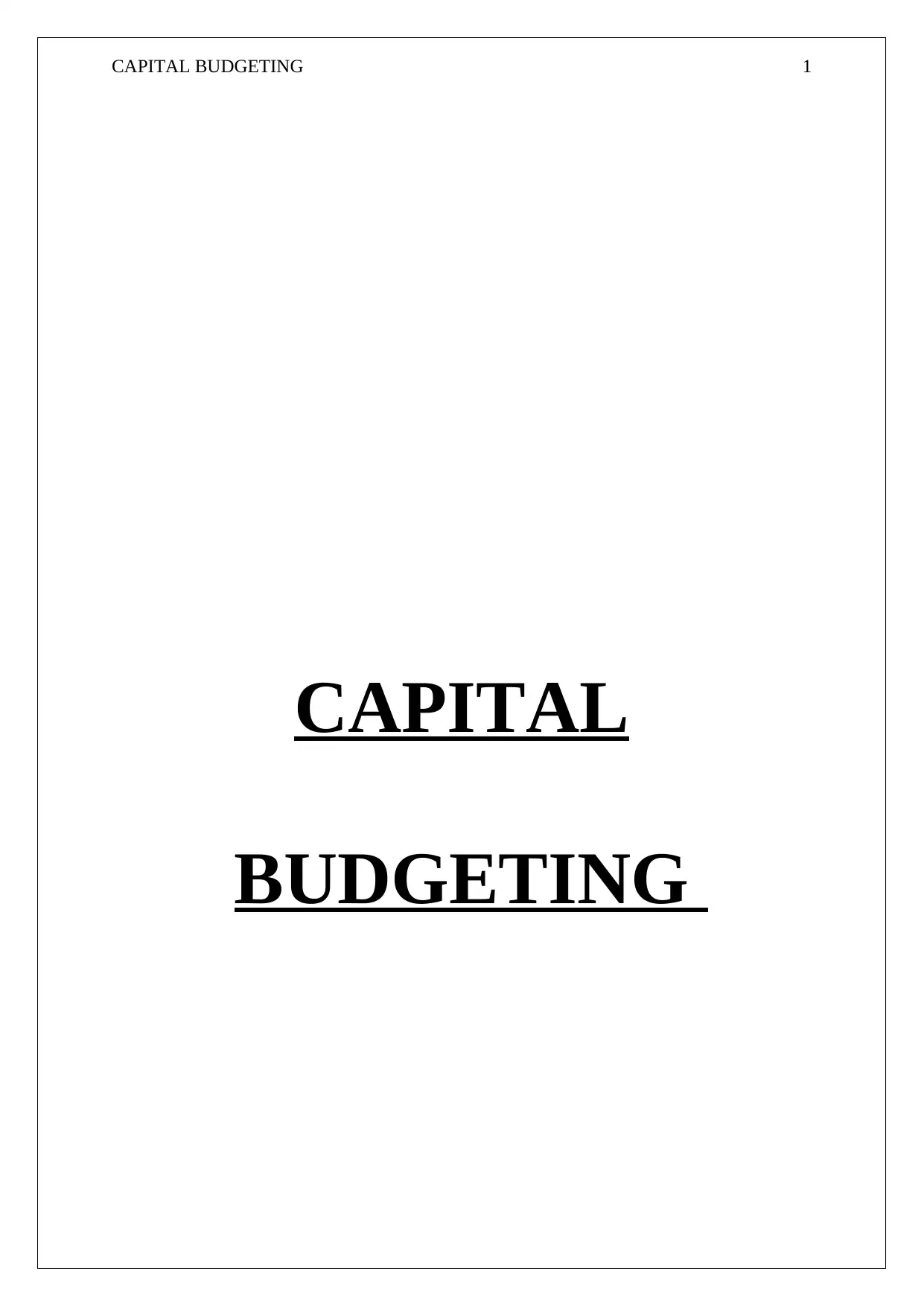
CAPITAL BUDGETING 1
CAPITAL
BUDGETING
CAPITAL
BUDGETING
Paraphrase This Document
Need a fresh take? Get an instant paraphrase of this document with our AI Paraphraser
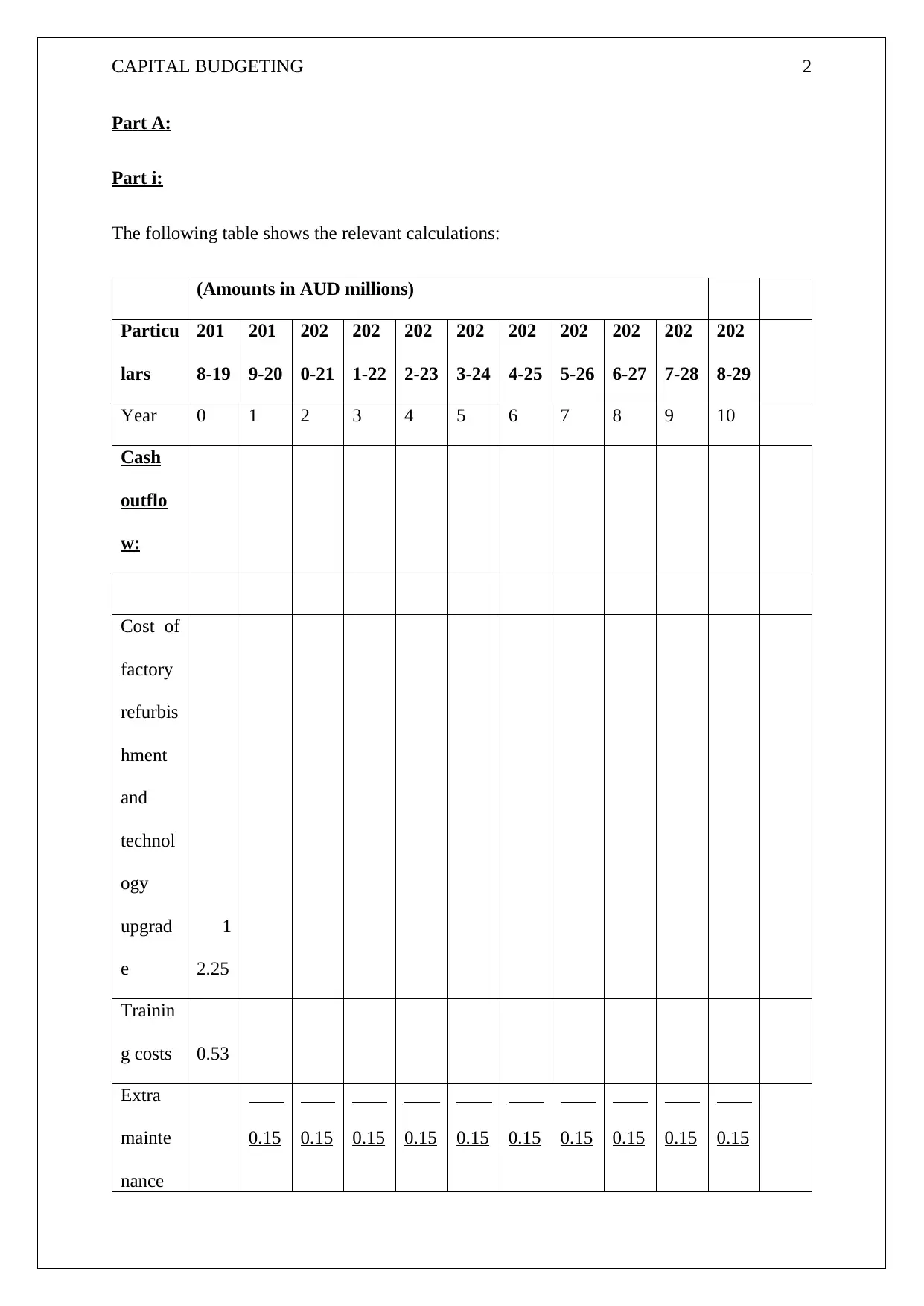
CAPITAL BUDGETING 2
Part A:
Part i:
The following table shows the relevant calculations:
(Amounts in AUD millions)
Particu
lars
201
8-19
201
9-20
202
0-21
202
1-22
202
2-23
202
3-24
202
4-25
202
5-26
202
6-27
202
7-28
202
8-29
Year 0 1 2 3 4 5 6 7 8 9 10
Cash
outflo
w:
Cost of
factory
refurbis
hment
and
technol
ogy
upgrad
e
1
2.25
Trainin
g costs 0.53
Extra
mainte
nance
0.15 0.15 0.15 0.15 0.15 0.15 0.15 0.15 0.15 0.15
Part A:
Part i:
The following table shows the relevant calculations:
(Amounts in AUD millions)
Particu
lars
201
8-19
201
9-20
202
0-21
202
1-22
202
2-23
202
3-24
202
4-25
202
5-26
202
6-27
202
7-28
202
8-29
Year 0 1 2 3 4 5 6 7 8 9 10
Cash
outflo
w:
Cost of
factory
refurbis
hment
and
technol
ogy
upgrad
e
1
2.25
Trainin
g costs 0.53
Extra
mainte
nance
0.15 0.15 0.15 0.15 0.15 0.15 0.15 0.15 0.15 0.15

CAPITAL BUDGETING 3
and IT
costs
Presen
t value
of the
cash
outflo
ws
-
12.7
8
-
0.15
-
0.15
-
0.15
-
0.15
-
0.15
-
0.15
-
0.15
-
0.15
-
0.15
-
0.15
Cash
inflow:
Salvage
value
of plant
and
equipm
ent 0.28
Savings
in
power
usage 0.91 0.91 0.91 0.91 0.91 0.91 0.91 0.91 0.91 0.91
Savings
in 0.42 0.42 0.42 0.42 0.42 0.42 0.42 0.42 0.42 0.42
and IT
costs
Presen
t value
of the
cash
outflo
ws
-
12.7
8
-
0.15
-
0.15
-
0.15
-
0.15
-
0.15
-
0.15
-
0.15
-
0.15
-
0.15
-
0.15
Cash
inflow:
Salvage
value
of plant
and
equipm
ent 0.28
Savings
in
power
usage 0.91 0.91 0.91 0.91 0.91 0.91 0.91 0.91 0.91 0.91
Savings
in 0.42 0.42 0.42 0.42 0.42 0.42 0.42 0.42 0.42 0.42
⊘ This is a preview!⊘
Do you want full access?
Subscribe today to unlock all pages.

Trusted by 1+ million students worldwide

CAPITAL BUDGETING 4
water
costs
Savings
in
labour 1.75 1.75 1.75 1.75 1.75 1.75 1.75 1.75 1.75 1.75
Salvage
value
of
anticipa
ted
technol
ogy 1.00
Presen
t value
of cash
inflow 0.28 3.08 3.08 3.08 3.08 3.08 3.08 3.08 3.08 3.08 4.08 2.92
Net
Cash
inflow
-
12.5
0 2.93 2.93 2.93 2.93 2.93 2.93 2.93 2.93 2.93 3.93
PV
Factor 1.00 0.83 0.69 0.58 0.48 0.40 0.33 0.28 0.23 0.19 0.16
-
12.5 2.45 2.04 1.70 1.42 1.18 0.98 0.82 0.68 0.57 0.64
water
costs
Savings
in
labour 1.75 1.75 1.75 1.75 1.75 1.75 1.75 1.75 1.75 1.75
Salvage
value
of
anticipa
ted
technol
ogy 1.00
Presen
t value
of cash
inflow 0.28 3.08 3.08 3.08 3.08 3.08 3.08 3.08 3.08 3.08 4.08 2.92
Net
Cash
inflow
-
12.5
0 2.93 2.93 2.93 2.93 2.93 2.93 2.93 2.93 2.93 3.93
PV
Factor 1.00 0.83 0.69 0.58 0.48 0.40 0.33 0.28 0.23 0.19 0.16
-
12.5 2.45 2.04 1.70 1.42 1.18 0.98 0.82 0.68 0.57 0.64
Paraphrase This Document
Need a fresh take? Get an instant paraphrase of this document with our AI Paraphraser
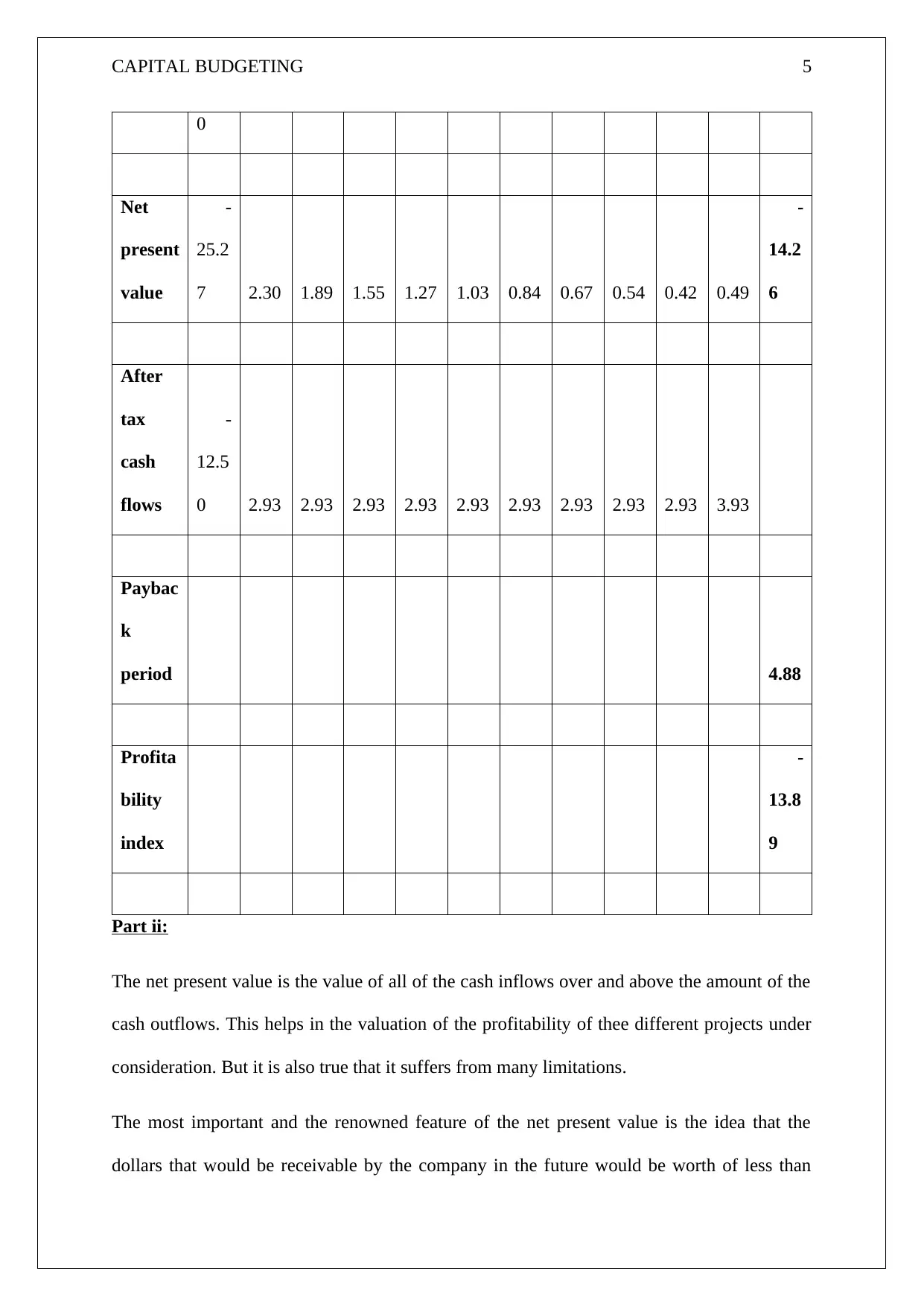
CAPITAL BUDGETING 5
0
Net
present
value
-
25.2
7 2.30 1.89 1.55 1.27 1.03 0.84 0.67 0.54 0.42 0.49
-
14.2
6
After
tax
cash
flows
-
12.5
0 2.93 2.93 2.93 2.93 2.93 2.93 2.93 2.93 2.93 3.93
Paybac
k
period 4.88
Profita
bility
index
-
13.8
9
Part ii:
The net present value is the value of all of the cash inflows over and above the amount of the
cash outflows. This helps in the valuation of the profitability of thee different projects under
consideration. But it is also true that it suffers from many limitations.
The most important and the renowned feature of the net present value is the idea that the
dollars that would be receivable by the company in the future would be worth of less than
0
Net
present
value
-
25.2
7 2.30 1.89 1.55 1.27 1.03 0.84 0.67 0.54 0.42 0.49
-
14.2
6
After
tax
cash
flows
-
12.5
0 2.93 2.93 2.93 2.93 2.93 2.93 2.93 2.93 2.93 3.93
Paybac
k
period 4.88
Profita
bility
index
-
13.8
9
Part ii:
The net present value is the value of all of the cash inflows over and above the amount of the
cash outflows. This helps in the valuation of the profitability of thee different projects under
consideration. But it is also true that it suffers from many limitations.
The most important and the renowned feature of the net present value is the idea that the
dollars that would be receivable by the company in the future would be worth of less than
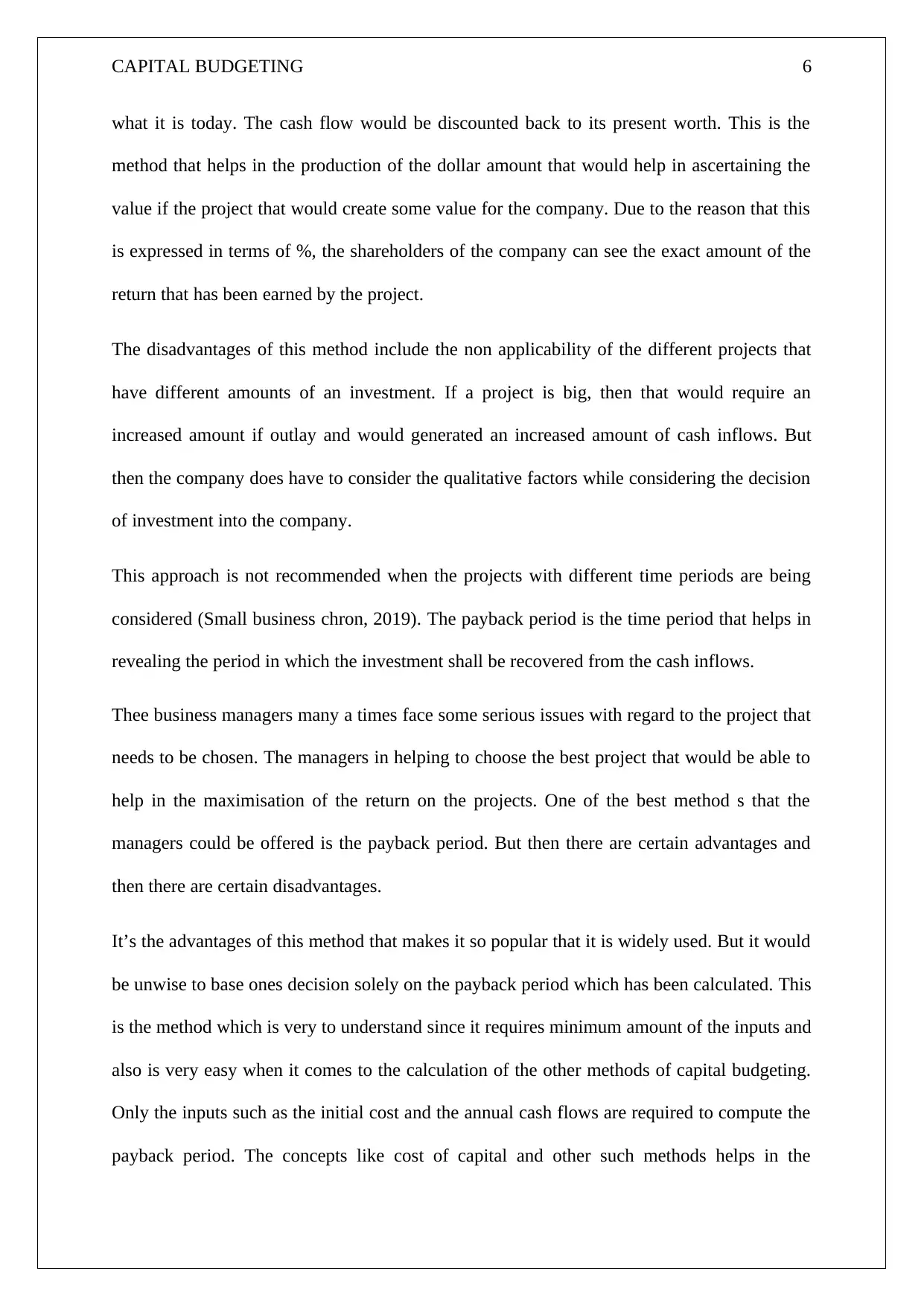
CAPITAL BUDGETING 6
what it is today. The cash flow would be discounted back to its present worth. This is the
method that helps in the production of the dollar amount that would help in ascertaining the
value if the project that would create some value for the company. Due to the reason that this
is expressed in terms of %, the shareholders of the company can see the exact amount of the
return that has been earned by the project.
The disadvantages of this method include the non applicability of the different projects that
have different amounts of an investment. If a project is big, then that would require an
increased amount if outlay and would generated an increased amount of cash inflows. But
then the company does have to consider the qualitative factors while considering the decision
of investment into the company.
This approach is not recommended when the projects with different time periods are being
considered (Small business chron, 2019). The payback period is the time period that helps in
revealing the period in which the investment shall be recovered from the cash inflows.
Thee business managers many a times face some serious issues with regard to the project that
needs to be chosen. The managers in helping to choose the best project that would be able to
help in the maximisation of the return on the projects. One of the best method s that the
managers could be offered is the payback period. But then there are certain advantages and
then there are certain disadvantages.
It’s the advantages of this method that makes it so popular that it is widely used. But it would
be unwise to base ones decision solely on the payback period which has been calculated. This
is the method which is very to understand since it requires minimum amount of the inputs and
also is very easy when it comes to the calculation of the other methods of capital budgeting.
Only the inputs such as the initial cost and the annual cash flows are required to compute the
payback period. The concepts like cost of capital and other such methods helps in the
what it is today. The cash flow would be discounted back to its present worth. This is the
method that helps in the production of the dollar amount that would help in ascertaining the
value if the project that would create some value for the company. Due to the reason that this
is expressed in terms of %, the shareholders of the company can see the exact amount of the
return that has been earned by the project.
The disadvantages of this method include the non applicability of the different projects that
have different amounts of an investment. If a project is big, then that would require an
increased amount if outlay and would generated an increased amount of cash inflows. But
then the company does have to consider the qualitative factors while considering the decision
of investment into the company.
This approach is not recommended when the projects with different time periods are being
considered (Small business chron, 2019). The payback period is the time period that helps in
revealing the period in which the investment shall be recovered from the cash inflows.
Thee business managers many a times face some serious issues with regard to the project that
needs to be chosen. The managers in helping to choose the best project that would be able to
help in the maximisation of the return on the projects. One of the best method s that the
managers could be offered is the payback period. But then there are certain advantages and
then there are certain disadvantages.
It’s the advantages of this method that makes it so popular that it is widely used. But it would
be unwise to base ones decision solely on the payback period which has been calculated. This
is the method which is very to understand since it requires minimum amount of the inputs and
also is very easy when it comes to the calculation of the other methods of capital budgeting.
Only the inputs such as the initial cost and the annual cash flows are required to compute the
payback period. The concepts like cost of capital and other such methods helps in the
⊘ This is a preview!⊘
Do you want full access?
Subscribe today to unlock all pages.

Trusted by 1+ million students worldwide
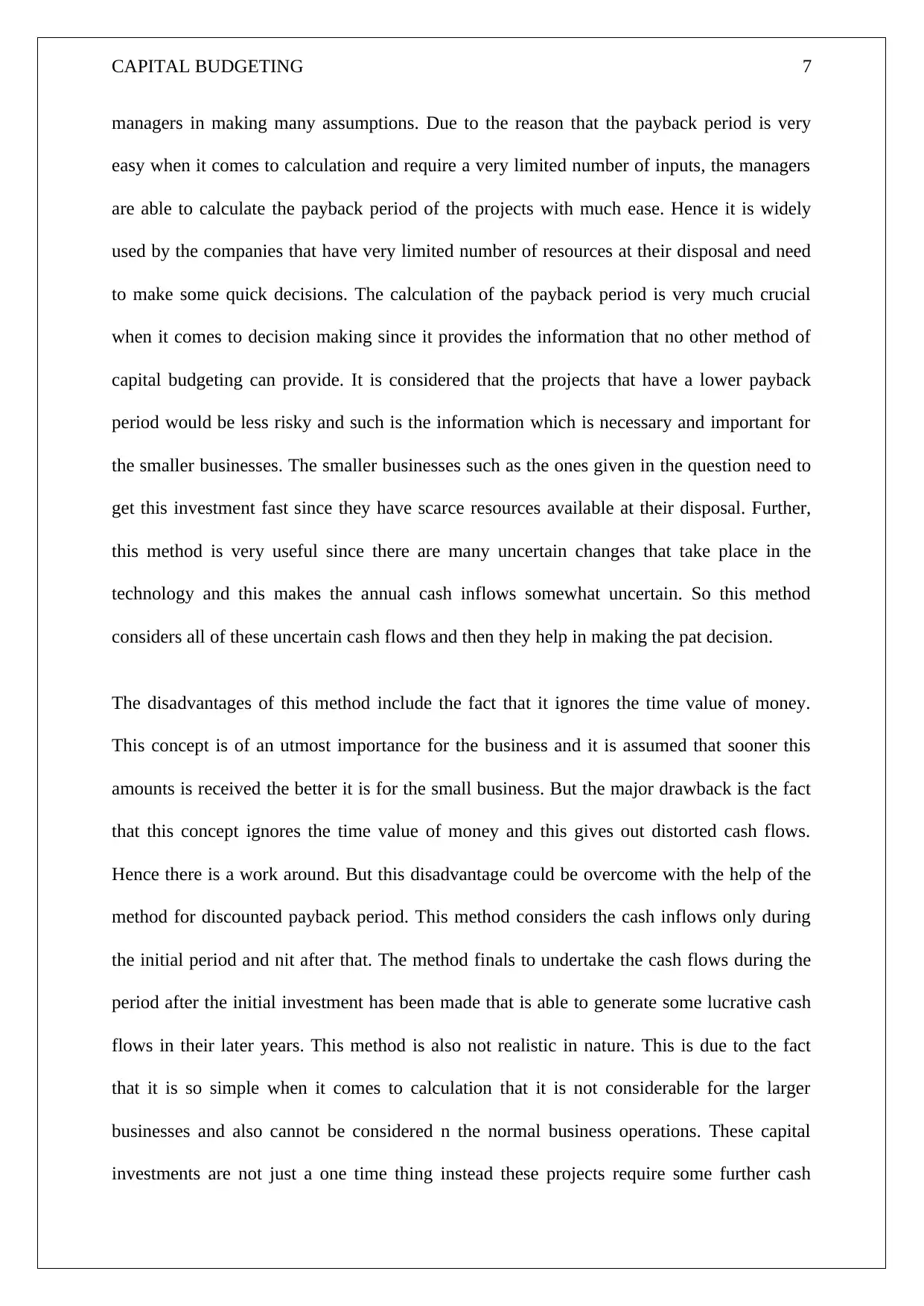
CAPITAL BUDGETING 7
managers in making many assumptions. Due to the reason that the payback period is very
easy when it comes to calculation and require a very limited number of inputs, the managers
are able to calculate the payback period of the projects with much ease. Hence it is widely
used by the companies that have very limited number of resources at their disposal and need
to make some quick decisions. The calculation of the payback period is very much crucial
when it comes to decision making since it provides the information that no other method of
capital budgeting can provide. It is considered that the projects that have a lower payback
period would be less risky and such is the information which is necessary and important for
the smaller businesses. The smaller businesses such as the ones given in the question need to
get this investment fast since they have scarce resources available at their disposal. Further,
this method is very useful since there are many uncertain changes that take place in the
technology and this makes the annual cash inflows somewhat uncertain. So this method
considers all of these uncertain cash flows and then they help in making the pat decision.
The disadvantages of this method include the fact that it ignores the time value of money.
This concept is of an utmost importance for the business and it is assumed that sooner this
amounts is received the better it is for the small business. But the major drawback is the fact
that this concept ignores the time value of money and this gives out distorted cash flows.
Hence there is a work around. But this disadvantage could be overcome with the help of the
method for discounted payback period. This method considers the cash inflows only during
the initial period and nit after that. The method finals to undertake the cash flows during the
period after the initial investment has been made that is able to generate some lucrative cash
flows in their later years. This method is also not realistic in nature. This is due to the fact
that it is so simple when it comes to calculation that it is not considerable for the larger
businesses and also cannot be considered n the normal business operations. These capital
investments are not just a one time thing instead these projects require some further cash
managers in making many assumptions. Due to the reason that the payback period is very
easy when it comes to calculation and require a very limited number of inputs, the managers
are able to calculate the payback period of the projects with much ease. Hence it is widely
used by the companies that have very limited number of resources at their disposal and need
to make some quick decisions. The calculation of the payback period is very much crucial
when it comes to decision making since it provides the information that no other method of
capital budgeting can provide. It is considered that the projects that have a lower payback
period would be less risky and such is the information which is necessary and important for
the smaller businesses. The smaller businesses such as the ones given in the question need to
get this investment fast since they have scarce resources available at their disposal. Further,
this method is very useful since there are many uncertain changes that take place in the
technology and this makes the annual cash inflows somewhat uncertain. So this method
considers all of these uncertain cash flows and then they help in making the pat decision.
The disadvantages of this method include the fact that it ignores the time value of money.
This concept is of an utmost importance for the business and it is assumed that sooner this
amounts is received the better it is for the small business. But the major drawback is the fact
that this concept ignores the time value of money and this gives out distorted cash flows.
Hence there is a work around. But this disadvantage could be overcome with the help of the
method for discounted payback period. This method considers the cash inflows only during
the initial period and nit after that. The method finals to undertake the cash flows during the
period after the initial investment has been made that is able to generate some lucrative cash
flows in their later years. This method is also not realistic in nature. This is due to the fact
that it is so simple when it comes to calculation that it is not considerable for the larger
businesses and also cannot be considered n the normal business operations. These capital
investments are not just a one time thing instead these projects require some further cash
Paraphrase This Document
Need a fresh take? Get an instant paraphrase of this document with our AI Paraphraser
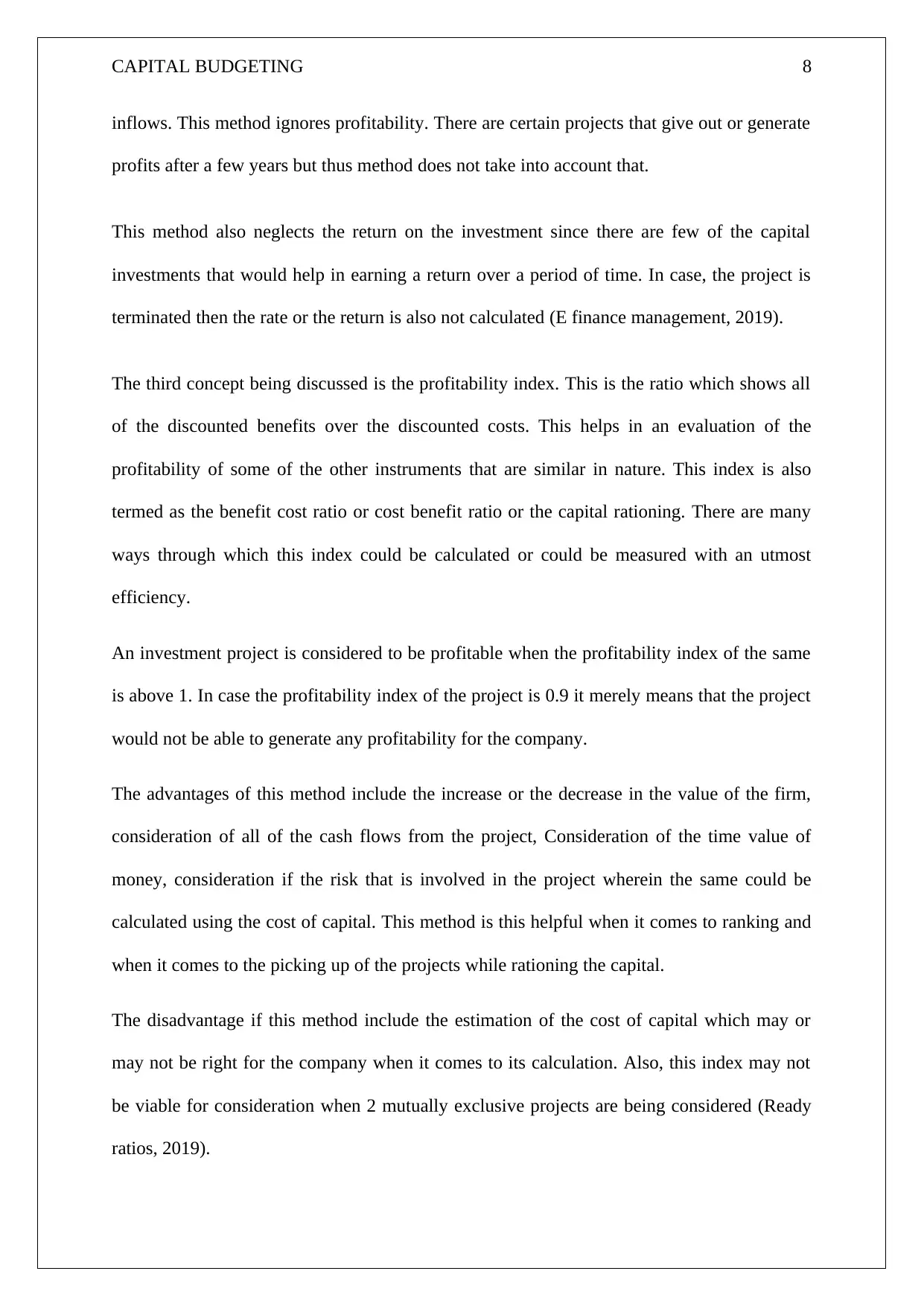
CAPITAL BUDGETING 8
inflows. This method ignores profitability. There are certain projects that give out or generate
profits after a few years but thus method does not take into account that.
This method also neglects the return on the investment since there are few of the capital
investments that would help in earning a return over a period of time. In case, the project is
terminated then the rate or the return is also not calculated (E finance management, 2019).
The third concept being discussed is the profitability index. This is the ratio which shows all
of the discounted benefits over the discounted costs. This helps in an evaluation of the
profitability of some of the other instruments that are similar in nature. This index is also
termed as the benefit cost ratio or cost benefit ratio or the capital rationing. There are many
ways through which this index could be calculated or could be measured with an utmost
efficiency.
An investment project is considered to be profitable when the profitability index of the same
is above 1. In case the profitability index of the project is 0.9 it merely means that the project
would not be able to generate any profitability for the company.
The advantages of this method include the increase or the decrease in the value of the firm,
consideration of all of the cash flows from the project, Consideration of the time value of
money, consideration if the risk that is involved in the project wherein the same could be
calculated using the cost of capital. This method is this helpful when it comes to ranking and
when it comes to the picking up of the projects while rationing the capital.
The disadvantage if this method include the estimation of the cost of capital which may or
may not be right for the company when it comes to its calculation. Also, this index may not
be viable for consideration when 2 mutually exclusive projects are being considered (Ready
ratios, 2019).
inflows. This method ignores profitability. There are certain projects that give out or generate
profits after a few years but thus method does not take into account that.
This method also neglects the return on the investment since there are few of the capital
investments that would help in earning a return over a period of time. In case, the project is
terminated then the rate or the return is also not calculated (E finance management, 2019).
The third concept being discussed is the profitability index. This is the ratio which shows all
of the discounted benefits over the discounted costs. This helps in an evaluation of the
profitability of some of the other instruments that are similar in nature. This index is also
termed as the benefit cost ratio or cost benefit ratio or the capital rationing. There are many
ways through which this index could be calculated or could be measured with an utmost
efficiency.
An investment project is considered to be profitable when the profitability index of the same
is above 1. In case the profitability index of the project is 0.9 it merely means that the project
would not be able to generate any profitability for the company.
The advantages of this method include the increase or the decrease in the value of the firm,
consideration of all of the cash flows from the project, Consideration of the time value of
money, consideration if the risk that is involved in the project wherein the same could be
calculated using the cost of capital. This method is this helpful when it comes to ranking and
when it comes to the picking up of the projects while rationing the capital.
The disadvantage if this method include the estimation of the cost of capital which may or
may not be right for the company when it comes to its calculation. Also, this index may not
be viable for consideration when 2 mutually exclusive projects are being considered (Ready
ratios, 2019).
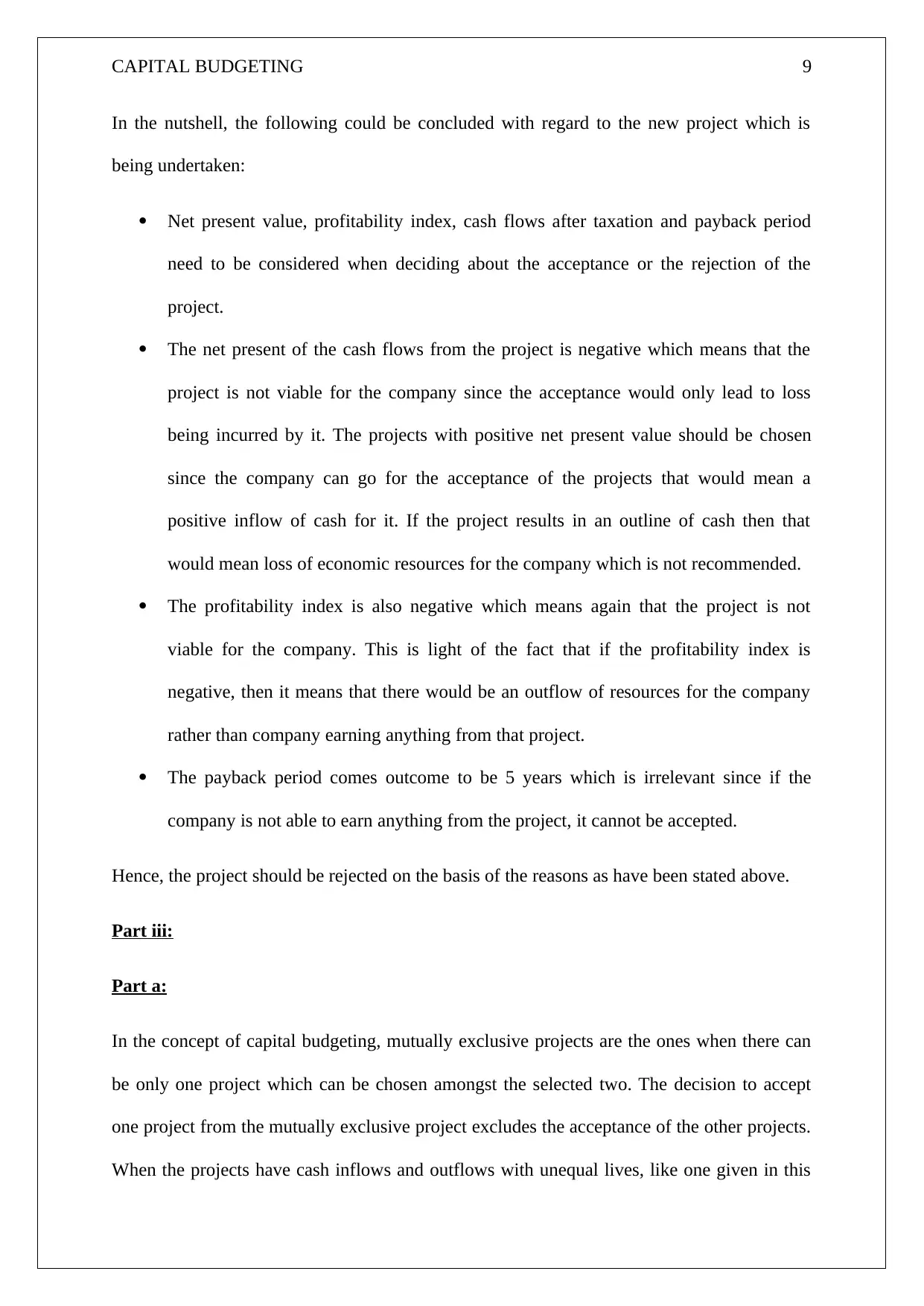
CAPITAL BUDGETING 9
In the nutshell, the following could be concluded with regard to the new project which is
being undertaken:
Net present value, profitability index, cash flows after taxation and payback period
need to be considered when deciding about the acceptance or the rejection of the
project.
The net present of the cash flows from the project is negative which means that the
project is not viable for the company since the acceptance would only lead to loss
being incurred by it. The projects with positive net present value should be chosen
since the company can go for the acceptance of the projects that would mean a
positive inflow of cash for it. If the project results in an outline of cash then that
would mean loss of economic resources for the company which is not recommended.
The profitability index is also negative which means again that the project is not
viable for the company. This is light of the fact that if the profitability index is
negative, then it means that there would be an outflow of resources for the company
rather than company earning anything from that project.
The payback period comes outcome to be 5 years which is irrelevant since if the
company is not able to earn anything from the project, it cannot be accepted.
Hence, the project should be rejected on the basis of the reasons as have been stated above.
Part iii:
Part a:
In the concept of capital budgeting, mutually exclusive projects are the ones when there can
be only one project which can be chosen amongst the selected two. The decision to accept
one project from the mutually exclusive project excludes the acceptance of the other projects.
When the projects have cash inflows and outflows with unequal lives, like one given in this
In the nutshell, the following could be concluded with regard to the new project which is
being undertaken:
Net present value, profitability index, cash flows after taxation and payback period
need to be considered when deciding about the acceptance or the rejection of the
project.
The net present of the cash flows from the project is negative which means that the
project is not viable for the company since the acceptance would only lead to loss
being incurred by it. The projects with positive net present value should be chosen
since the company can go for the acceptance of the projects that would mean a
positive inflow of cash for it. If the project results in an outline of cash then that
would mean loss of economic resources for the company which is not recommended.
The profitability index is also negative which means again that the project is not
viable for the company. This is light of the fact that if the profitability index is
negative, then it means that there would be an outflow of resources for the company
rather than company earning anything from that project.
The payback period comes outcome to be 5 years which is irrelevant since if the
company is not able to earn anything from the project, it cannot be accepted.
Hence, the project should be rejected on the basis of the reasons as have been stated above.
Part iii:
Part a:
In the concept of capital budgeting, mutually exclusive projects are the ones when there can
be only one project which can be chosen amongst the selected two. The decision to accept
one project from the mutually exclusive project excludes the acceptance of the other projects.
When the projects have cash inflows and outflows with unequal lives, like one given in this
⊘ This is a preview!⊘
Do you want full access?
Subscribe today to unlock all pages.

Trusted by 1+ million students worldwide
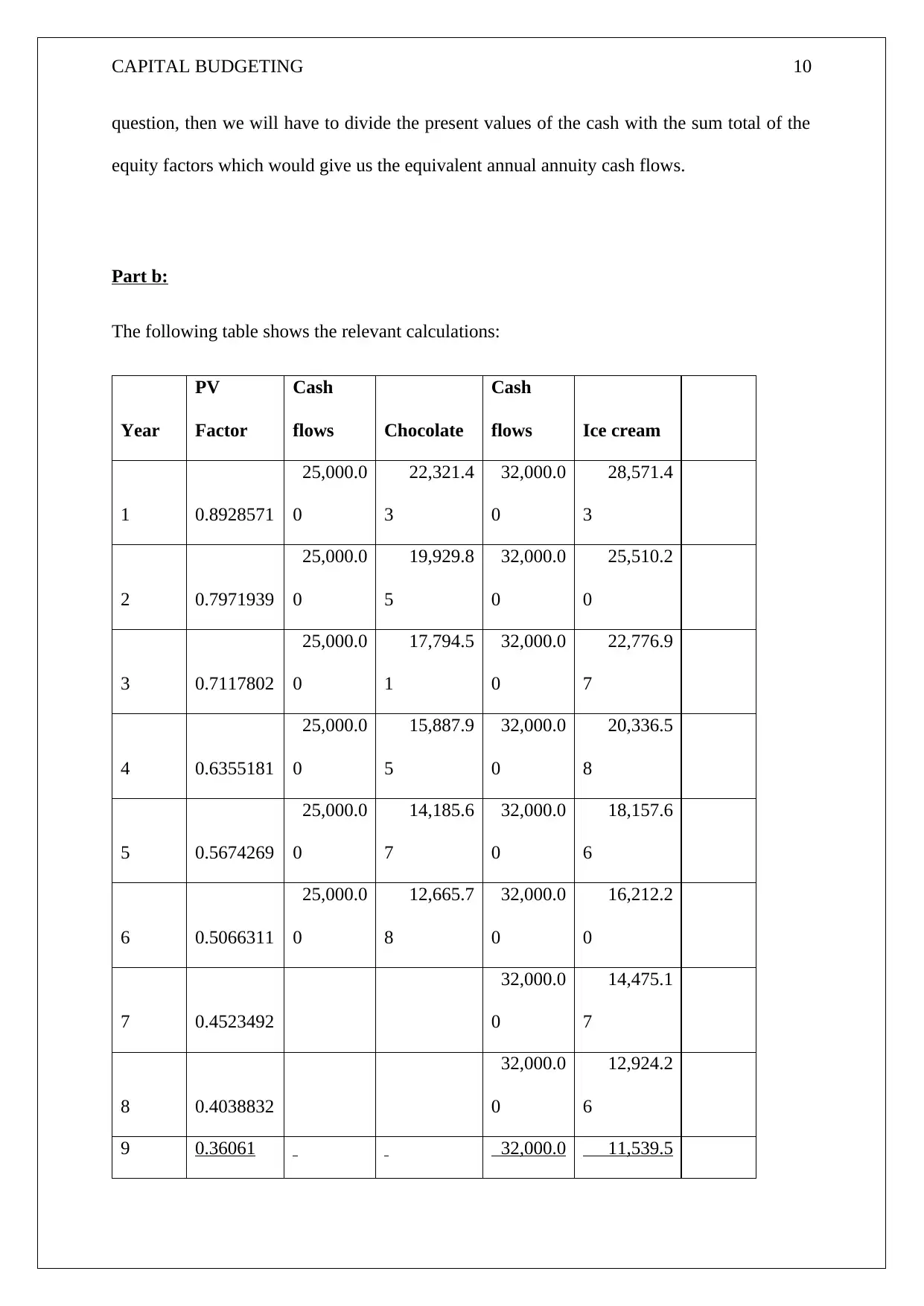
CAPITAL BUDGETING 10
question, then we will have to divide the present values of the cash with the sum total of the
equity factors which would give us the equivalent annual annuity cash flows.
Part b:
The following table shows the relevant calculations:
Year
PV
Factor
Cash
flows Chocolate
Cash
flows Ice cream
1 0.8928571
25,000.0
0
22,321.4
3
32,000.0
0
28,571.4
3
2 0.7971939
25,000.0
0
19,929.8
5
32,000.0
0
25,510.2
0
3 0.7117802
25,000.0
0
17,794.5
1
32,000.0
0
22,776.9
7
4 0.6355181
25,000.0
0
15,887.9
5
32,000.0
0
20,336.5
8
5 0.5674269
25,000.0
0
14,185.6
7
32,000.0
0
18,157.6
6
6 0.5066311
25,000.0
0
12,665.7
8
32,000.0
0
16,212.2
0
7 0.4523492
32,000.0
0
14,475.1
7
8 0.4038832
32,000.0
0
12,924.2
6
9 0.36061 32,000.0 11,539.5
question, then we will have to divide the present values of the cash with the sum total of the
equity factors which would give us the equivalent annual annuity cash flows.
Part b:
The following table shows the relevant calculations:
Year
PV
Factor
Cash
flows Chocolate
Cash
flows Ice cream
1 0.8928571
25,000.0
0
22,321.4
3
32,000.0
0
28,571.4
3
2 0.7971939
25,000.0
0
19,929.8
5
32,000.0
0
25,510.2
0
3 0.7117802
25,000.0
0
17,794.5
1
32,000.0
0
22,776.9
7
4 0.6355181
25,000.0
0
15,887.9
5
32,000.0
0
20,336.5
8
5 0.5674269
25,000.0
0
14,185.6
7
32,000.0
0
18,157.6
6
6 0.5066311
25,000.0
0
12,665.7
8
32,000.0
0
16,212.2
0
7 0.4523492
32,000.0
0
14,475.1
7
8 0.4038832
32,000.0
0
12,924.2
6
9 0.36061 32,000.0 11,539.5
Paraphrase This Document
Need a fresh take? Get an instant paraphrase of this document with our AI Paraphraser
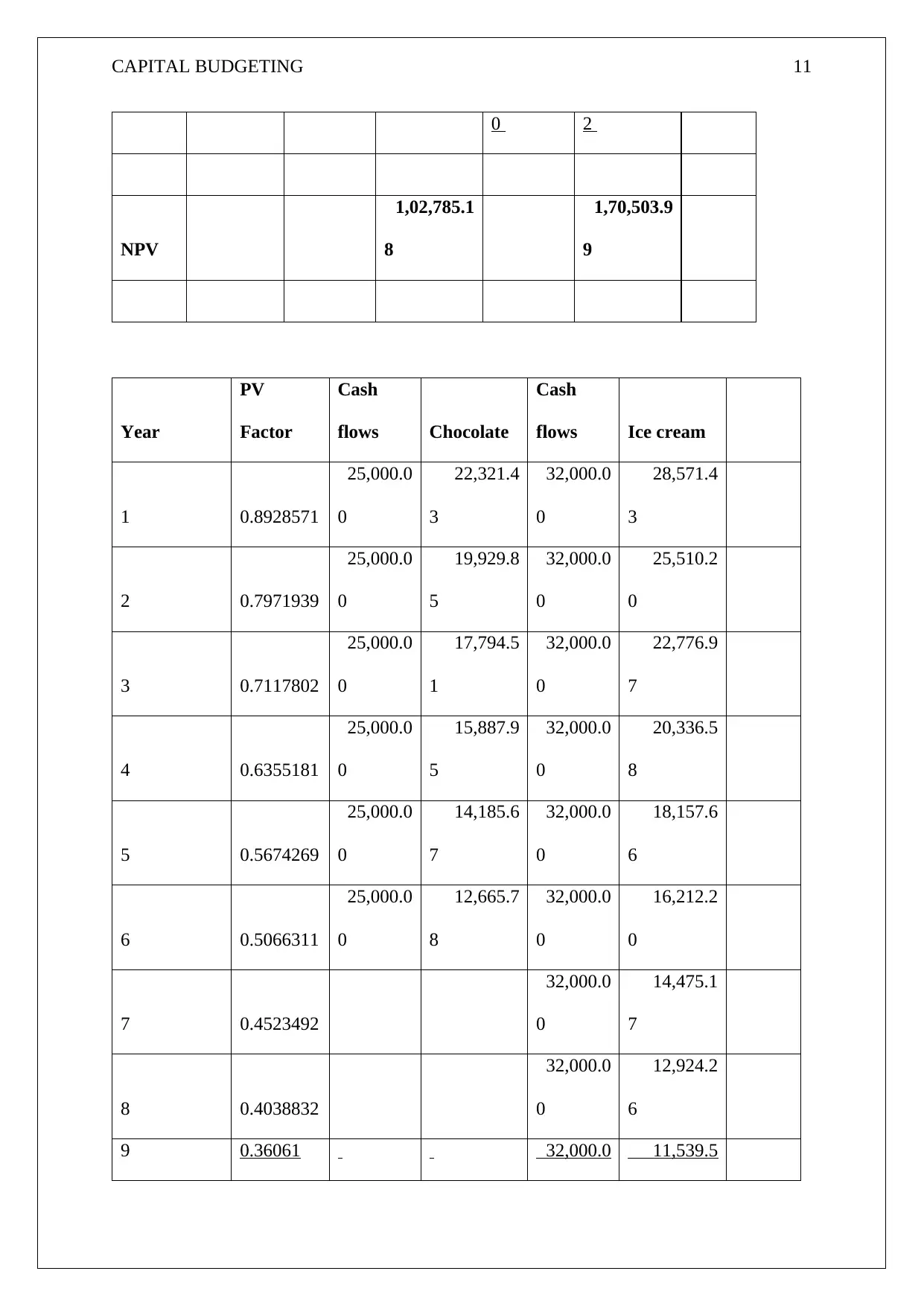
CAPITAL BUDGETING 11
0 2
NPV
1,02,785.1
8
1,70,503.9
9
Year
PV
Factor
Cash
flows Chocolate
Cash
flows Ice cream
1 0.8928571
25,000.0
0
22,321.4
3
32,000.0
0
28,571.4
3
2 0.7971939
25,000.0
0
19,929.8
5
32,000.0
0
25,510.2
0
3 0.7117802
25,000.0
0
17,794.5
1
32,000.0
0
22,776.9
7
4 0.6355181
25,000.0
0
15,887.9
5
32,000.0
0
20,336.5
8
5 0.5674269
25,000.0
0
14,185.6
7
32,000.0
0
18,157.6
6
6 0.5066311
25,000.0
0
12,665.7
8
32,000.0
0
16,212.2
0
7 0.4523492
32,000.0
0
14,475.1
7
8 0.4038832
32,000.0
0
12,924.2
6
9 0.36061 32,000.0 11,539.5
0 2
NPV
1,02,785.1
8
1,70,503.9
9
Year
PV
Factor
Cash
flows Chocolate
Cash
flows Ice cream
1 0.8928571
25,000.0
0
22,321.4
3
32,000.0
0
28,571.4
3
2 0.7971939
25,000.0
0
19,929.8
5
32,000.0
0
25,510.2
0
3 0.7117802
25,000.0
0
17,794.5
1
32,000.0
0
22,776.9
7
4 0.6355181
25,000.0
0
15,887.9
5
32,000.0
0
20,336.5
8
5 0.5674269
25,000.0
0
14,185.6
7
32,000.0
0
18,157.6
6
6 0.5066311
25,000.0
0
12,665.7
8
32,000.0
0
16,212.2
0
7 0.4523492
32,000.0
0
14,475.1
7
8 0.4038832
32,000.0
0
12,924.2
6
9 0.36061 32,000.0 11,539.5
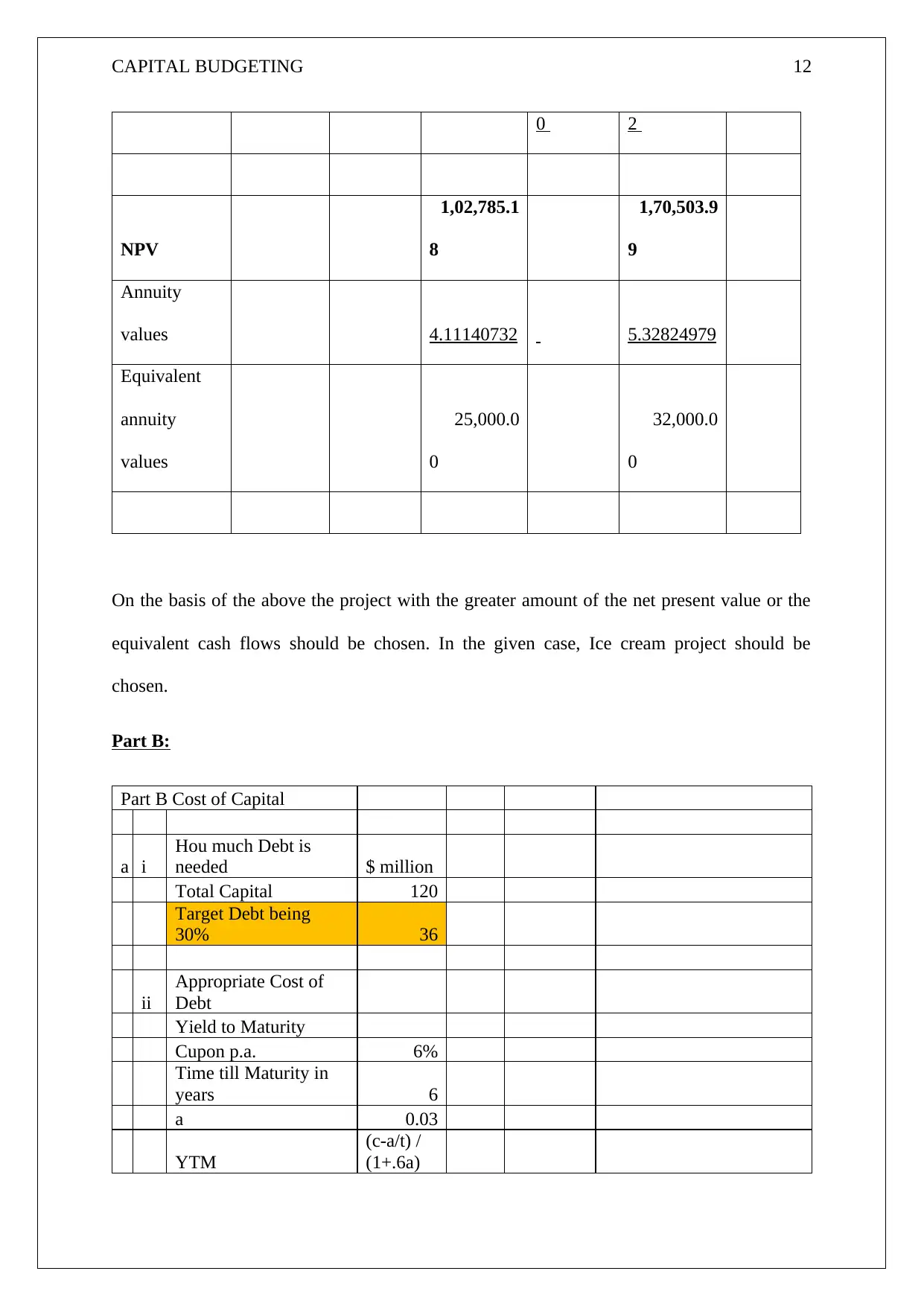
CAPITAL BUDGETING 12
0 2
NPV
1,02,785.1
8
1,70,503.9
9
Annuity
values 4.11140732 5.32824979
Equivalent
annuity
values
25,000.0
0
32,000.0
0
On the basis of the above the project with the greater amount of the net present value or the
equivalent cash flows should be chosen. In the given case, Ice cream project should be
chosen.
Part B:
Part B Cost of Capital
a i
Hou much Debt is
needed $ million
Total Capital 120
Target Debt being
30% 36
ii
Appropriate Cost of
Debt
Yield to Maturity
Cupon p.a. 6%
Time till Maturity in
years 6
a 0.03
YTM
(c-a/t) /
(1+.6a)
0 2
NPV
1,02,785.1
8
1,70,503.9
9
Annuity
values 4.11140732 5.32824979
Equivalent
annuity
values
25,000.0
0
32,000.0
0
On the basis of the above the project with the greater amount of the net present value or the
equivalent cash flows should be chosen. In the given case, Ice cream project should be
chosen.
Part B:
Part B Cost of Capital
a i
Hou much Debt is
needed $ million
Total Capital 120
Target Debt being
30% 36
ii
Appropriate Cost of
Debt
Yield to Maturity
Cupon p.a. 6%
Time till Maturity in
years 6
a 0.03
YTM
(c-a/t) /
(1+.6a)
⊘ This is a preview!⊘
Do you want full access?
Subscribe today to unlock all pages.

Trusted by 1+ million students worldwide
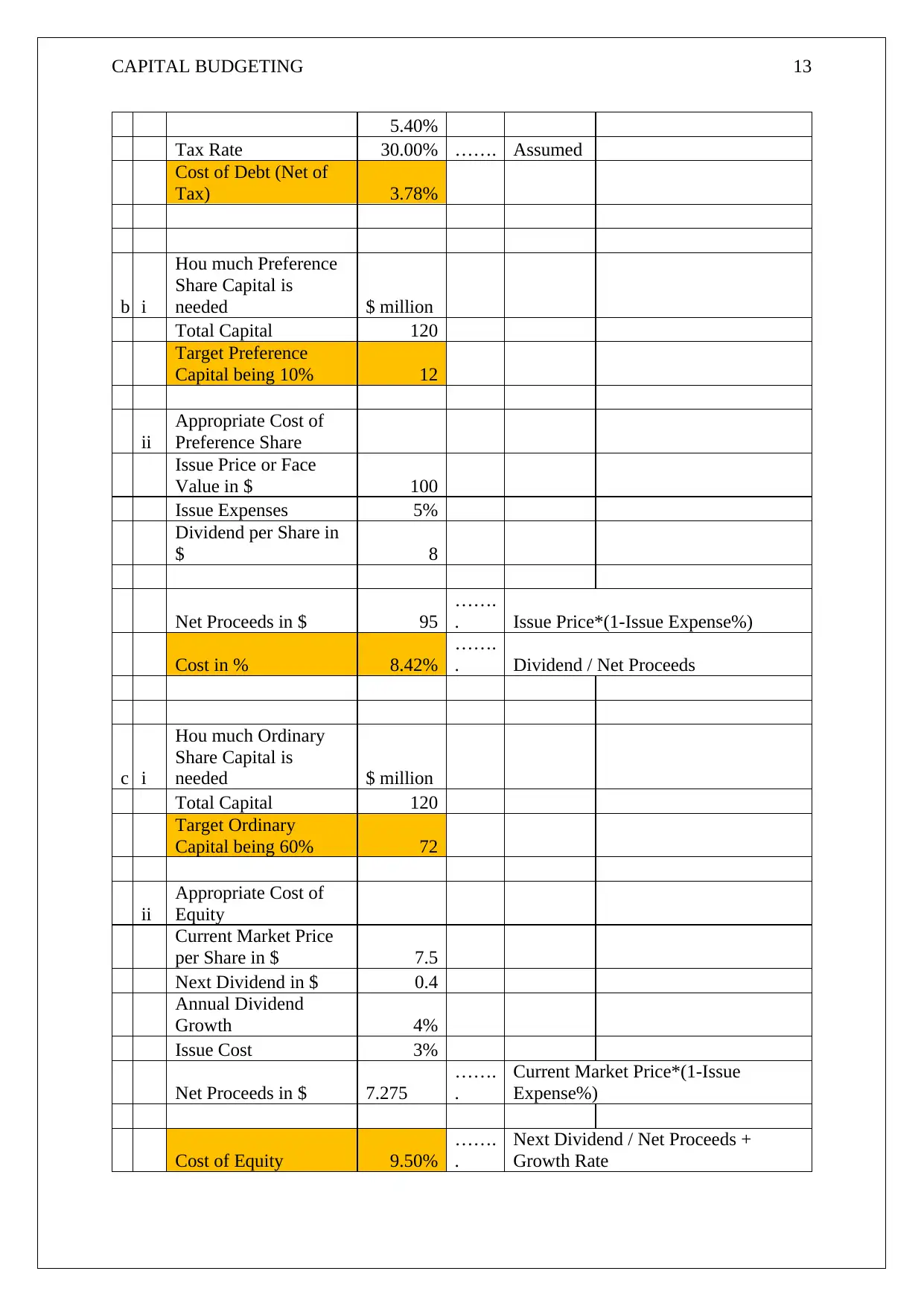
CAPITAL BUDGETING 13
5.40%
Tax Rate 30.00% ……. Assumed
Cost of Debt (Net of
Tax) 3.78%
b i
Hou much Preference
Share Capital is
needed $ million
Total Capital 120
Target Preference
Capital being 10% 12
ii
Appropriate Cost of
Preference Share
Issue Price or Face
Value in $ 100
Issue Expenses 5%
Dividend per Share in
$ 8
Net Proceeds in $ 95
…….
. Issue Price*(1-Issue Expense%)
Cost in % 8.42%
…….
. Dividend / Net Proceeds
c i
Hou much Ordinary
Share Capital is
needed $ million
Total Capital 120
Target Ordinary
Capital being 60% 72
ii
Appropriate Cost of
Equity
Current Market Price
per Share in $ 7.5
Next Dividend in $ 0.4
Annual Dividend
Growth 4%
Issue Cost 3%
Net Proceeds in $ 7.275
…….
.
Current Market Price*(1-Issue
Expense%)
Cost of Equity 9.50%
…….
.
Next Dividend / Net Proceeds +
Growth Rate
5.40%
Tax Rate 30.00% ……. Assumed
Cost of Debt (Net of
Tax) 3.78%
b i
Hou much Preference
Share Capital is
needed $ million
Total Capital 120
Target Preference
Capital being 10% 12
ii
Appropriate Cost of
Preference Share
Issue Price or Face
Value in $ 100
Issue Expenses 5%
Dividend per Share in
$ 8
Net Proceeds in $ 95
…….
. Issue Price*(1-Issue Expense%)
Cost in % 8.42%
…….
. Dividend / Net Proceeds
c i
Hou much Ordinary
Share Capital is
needed $ million
Total Capital 120
Target Ordinary
Capital being 60% 72
ii
Appropriate Cost of
Equity
Current Market Price
per Share in $ 7.5
Next Dividend in $ 0.4
Annual Dividend
Growth 4%
Issue Cost 3%
Net Proceeds in $ 7.275
…….
.
Current Market Price*(1-Issue
Expense%)
Cost of Equity 9.50%
…….
.
Next Dividend / Net Proceeds +
Growth Rate
Paraphrase This Document
Need a fresh take? Get an instant paraphrase of this document with our AI Paraphraser
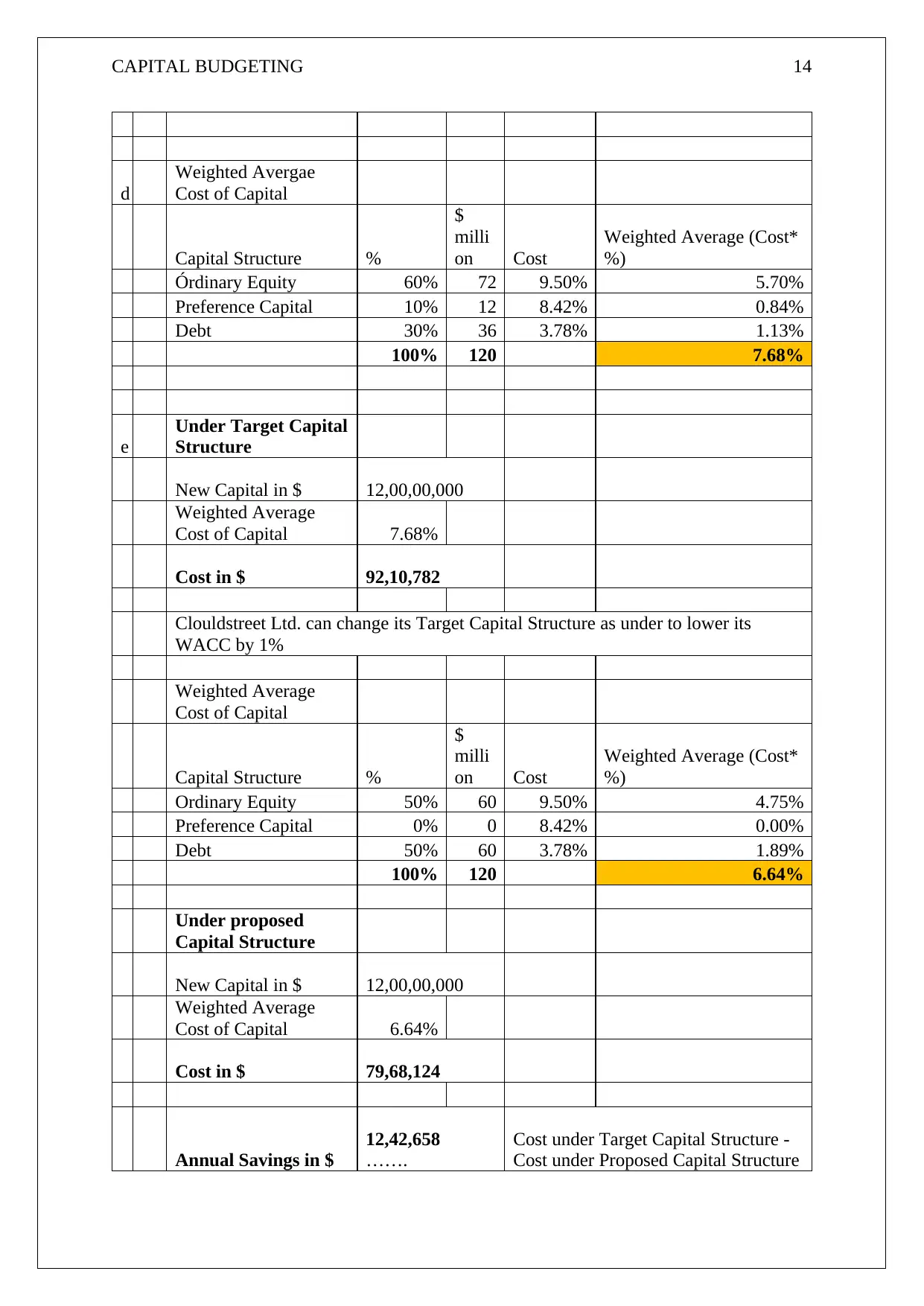
CAPITAL BUDGETING 14
d
Weighted Avergae
Cost of Capital
Capital Structure %
$
milli
on Cost
Weighted Average (Cost*
%)
Órdinary Equity 60% 72 9.50% 5.70%
Preference Capital 10% 12 8.42% 0.84%
Debt 30% 36 3.78% 1.13%
100% 120 7.68%
e
Under Target Capital
Structure
New Capital in $ 12,00,00,000
Weighted Average
Cost of Capital 7.68%
Cost in $ 92,10,782
Clouldstreet Ltd. can change its Target Capital Structure as under to lower its
WACC by 1%
Weighted Average
Cost of Capital
Capital Structure %
$
milli
on Cost
Weighted Average (Cost*
%)
Ordinary Equity 50% 60 9.50% 4.75%
Preference Capital 0% 0 8.42% 0.00%
Debt 50% 60 3.78% 1.89%
100% 120 6.64%
Under proposed
Capital Structure
New Capital in $ 12,00,00,000
Weighted Average
Cost of Capital 6.64%
Cost in $ 79,68,124
Annual Savings in $
12,42,658
…….
Cost under Target Capital Structure -
Cost under Proposed Capital Structure
d
Weighted Avergae
Cost of Capital
Capital Structure %
$
milli
on Cost
Weighted Average (Cost*
%)
Órdinary Equity 60% 72 9.50% 5.70%
Preference Capital 10% 12 8.42% 0.84%
Debt 30% 36 3.78% 1.13%
100% 120 7.68%
e
Under Target Capital
Structure
New Capital in $ 12,00,00,000
Weighted Average
Cost of Capital 7.68%
Cost in $ 92,10,782
Clouldstreet Ltd. can change its Target Capital Structure as under to lower its
WACC by 1%
Weighted Average
Cost of Capital
Capital Structure %
$
milli
on Cost
Weighted Average (Cost*
%)
Ordinary Equity 50% 60 9.50% 4.75%
Preference Capital 0% 0 8.42% 0.00%
Debt 50% 60 3.78% 1.89%
100% 120 6.64%
Under proposed
Capital Structure
New Capital in $ 12,00,00,000
Weighted Average
Cost of Capital 6.64%
Cost in $ 79,68,124
Annual Savings in $
12,42,658
…….
Cost under Target Capital Structure -
Cost under Proposed Capital Structure

CAPITAL BUDGETING 15
Cloudstreet would be able to add approximately $ 1.2 million every year after
servicing its capital i.e. to its retained earnings. This will increase the value of the
company and the amount can be utilised to fund future capex / expansion plans
through internal resources without having to raise fresh capital from the market.
Cloudstreet would be able to add approximately $ 1.2 million every year after
servicing its capital i.e. to its retained earnings. This will increase the value of the
company and the amount can be utilised to fund future capex / expansion plans
through internal resources without having to raise fresh capital from the market.
⊘ This is a preview!⊘
Do you want full access?
Subscribe today to unlock all pages.

Trusted by 1+ million students worldwide
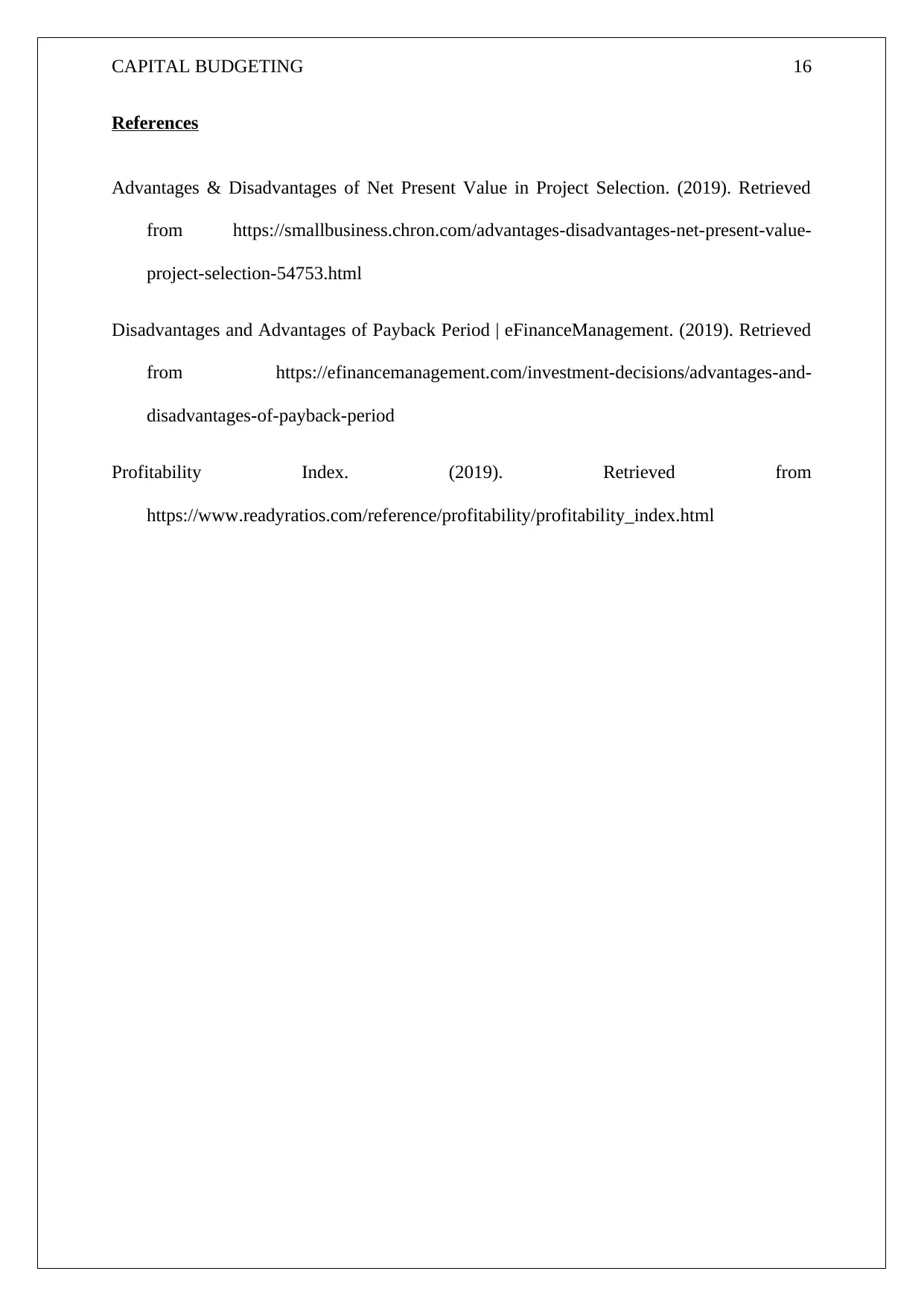
CAPITAL BUDGETING 16
References
Advantages & Disadvantages of Net Present Value in Project Selection. (2019). Retrieved
from https://smallbusiness.chron.com/advantages-disadvantages-net-present-value-
project-selection-54753.html
Disadvantages and Advantages of Payback Period | eFinanceManagement. (2019). Retrieved
from https://efinancemanagement.com/investment-decisions/advantages-and-
disadvantages-of-payback-period
Profitability Index. (2019). Retrieved from
https://www.readyratios.com/reference/profitability/profitability_index.html
References
Advantages & Disadvantages of Net Present Value in Project Selection. (2019). Retrieved
from https://smallbusiness.chron.com/advantages-disadvantages-net-present-value-
project-selection-54753.html
Disadvantages and Advantages of Payback Period | eFinanceManagement. (2019). Retrieved
from https://efinancemanagement.com/investment-decisions/advantages-and-
disadvantages-of-payback-period
Profitability Index. (2019). Retrieved from
https://www.readyratios.com/reference/profitability/profitability_index.html
1 out of 16
Your All-in-One AI-Powered Toolkit for Academic Success.
+13062052269
info@desklib.com
Available 24*7 on WhatsApp / Email
![[object Object]](/_next/static/media/star-bottom.7253800d.svg)
Unlock your academic potential
© 2024 | Zucol Services PVT LTD | All rights reserved.
